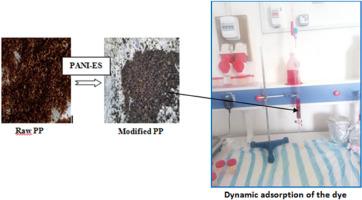Sustainable dye removal using PANI-salt functionalized potato peels in a fixed-bed column: Optimization and modeling
IF 3.4
4区 化学
Q2 CHEMISTRY, MULTIDISCIPLINARY
引用次数: 0
Abstract
This study investigates a practical and low-cost approach for the removal of multiple dyes (Basic Fuchsin (BF), Methylene Blue (MB), Malachite Green (MG), Rhodamine B (RhB), Congo Red (CR), and Bordeaux B (BB)) from aqueous solutions using dynamic fixed-bed adsorption. Native potato peels (PP), a biodegradable biosorbent, were chemically modified with polyaniline in its emeraldine salt form (PANI-ES) to enhance adsorption performance. The optimal operational parameters were as follows: dye concentration of 30 mg/L, bed height of 8 cm, particle size of 1 mm, flow rate of 7.5 mL/min, and pH 6.5. The adsorption capacity of unmodified PP correlated inversely with dye molecular weight, while PANI-ES grafting significantly extended breakthrough times from 356 to 400.18 min for BF, 219 to 387.68 min for MB, 96.2 to 373.3 min for MG, 141.62 to 359.15 min for RhB, and 68.1 to 363.52 min for CR, achieving maximum dye removal efficiencies of 99.67 % (BF), 99.88 % (MB), 98.01 % (MG), 94.41 % (RhB), and 92.08 % (CR), respectively. The developed biosorbent was characterized using Fourier-transform infrared spectroscopy (FTIR), scanning electron microscopy (SEM), atomic force microscopy (AFM), Raman spectroscopy, and X-ray diffraction (XRD). Breakthrough data were fitted using the Adams–Bohart, Thomas, Yoon–Nelson, and bed depth service time (BDST) models, highlighting the potential of PANI-functionalized agro-waste for efficient and sustainable wastewater treatment.

在固定床柱中使用聚苯胺盐功能化马铃薯皮可持续去除染料:优化和建模
本研究研究了一种实用且低成本的方法,用于动态固定床吸附去除水溶液中的多种染料(碱性紫红(BF)、亚甲基蓝(MB)、孔雀石绿(MG)、罗丹明B (RhB)、刚果红(CR)和波尔多B (BB))。以天然马铃薯皮(PP)为吸附剂,用聚苯胺对其绿宝石盐形态(PANI-ES)进行化学改性,以提高其吸附性能。最佳操作参数为:染料浓度30 mg/L,床高8 cm,粒径1 mm,流速7.5 mL/min, pH 6.5。未改性PP的吸附量与染料分子量呈负相关,而接枝PANI-ES显著延长了突破时间,BF为356 ~ 400.18 min, MB为219 ~ 387.68 min, MG为96.2 ~ 373.3 min, RhB为141.62 ~ 359.15 min, CR为68.1 ~ 363.52 min,最大染料去除率分别为99.67% (BF)、99.88% (MB)、98.01% (MG)、94.41% (RhB)和92.08% (CR)。采用傅里叶变换红外光谱(FTIR)、扫描电镜(SEM)、原子力显微镜(AFM)、拉曼光谱(Raman)和x射线衍射(XRD)对所制备的生物吸附剂进行了表征。采用Adams-Bohart、Thomas、Yoon-Nelson和床深服务时间(BDST)模型拟合了突破性数据,突出了聚苯胺功能化农业废弃物在高效和可持续废水处理方面的潜力。
本文章由计算机程序翻译,如有差异,请以英文原文为准。
求助全文
约1分钟内获得全文
求助全文
来源期刊
CiteScore
3.50
自引率
7.70%
发文量
492
审稿时长
3-8 weeks
期刊介绍:
The Journal of the Indian Chemical Society publishes original, fundamental, theorical, experimental research work of highest quality in all areas of chemistry, biochemistry, medicinal chemistry, electrochemistry, agrochemistry, chemical engineering and technology, food chemistry, environmental chemistry, etc.

 求助内容:
求助内容: 应助结果提醒方式:
应助结果提醒方式:


